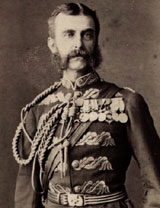Constitutional Development (1858 – 1947)
5. An Indian member was appointed for the first time to the Governor-General’s Executive Council. Sir S. P. Sinha was- the first Indian to be appointed thus.
6. In Bombay and Madras, the number of members of the Executive Councils was raised from 2 to 4. The practice of appointing Indians to these Councils began.
7. Two Indians were also appointed to the India Council [in
England].
The Minto- Morley reforms never desired to set up a parliamentary form of government in India. However, the Moderates welcomed the reforms as fairly liberal measures. The principle of separate electorates had ultimately led to the partition of India in
1947.
Montague-Chelmsford Reforms of 1919
 |
| Lord Chelmsford |
This Act is popularly known as Montague-Chelmsford Reforms. At that time Lord Chelmsford was the Viceroy of India.
The main features of the Act were:
1 . Dyarchy was introduced in the provinces. Provincial subjects were divided into “Reserved Subjects” such as police, jails, land revenue, irrigation and forests and “Transferred Subjects” such as education, local self-government, public health, sanitation, agriculture and industries. The Reserved subjects were to be administered by the Governor and his Executive Council. The Transferred subjects by the Governor and his ministers.
Information related to the search:
Constitutional Development (1858 – 1947), india, history, government, reforms, first, governor, chelmsford, constitutional, subjects, declaration, executive, montague, council, councils, development, appointed, transferred, subjects&rdquo, &ldquo, reserved, august, lord, england, indians, indian, public, budget, time